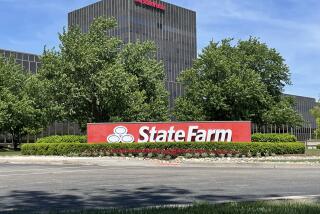Assigned-Risk Car Insurance Rate Hike of 112.3% Sought
A 112.3% average statewide increase in auto insurance rates for the 780,000 drivers insured under California’s assigned-risk program was requested Tuesday by the plan’s governing board, composed largely of insurance company executives.
The request is subject to approval by state Insurance Commissioner Roxani Gillespie, who in the past has held assigned-risk rates well below what insurers wanted. She responded noncommittally when asked about the new request.
“I really don’t know what I will do,” Gillespie said in an interview. “I have absolutely no idea.”
Gillespie noted that she is required to hold a public hearing before approving any increase.
Under the request of the insurers, the average annual assigned-risk rate statewide would rise from about $700 to $1,488 for the minimum coverage required under the state’s mandatory insurance law. This is about 17% of the annual income, before taxes, of someone who earns the California minimum wage of $4.25 an hour.
Driving Record
In Central Los Angeles, the proposed rate increase is 137%, the maximum being asked anywhere in the state. Depending on the driving record, age and other characteristics of the driver, this would mean an annual rate varying from $1,508 to $2,187 in the inner city. The coverage would include liability but not collision and theft.
Under the assigned-risk system, drivers who either cannot get insurance or who choose not to buy regular coverage are assigned to companies. The percentage of assigned-risk cases referred to a company is based on its share of the overall California auto insurance market. Theoretically, assigned-risk prices should be higher than regular coverage, because many drivers with poor records are insured, but in Los Angeles and some urban areas, Gillespie has set the price lower for several years.
Accordingly, more and more people, including many good drivers, have been buying assigned-risk coverage, and the insurance companies say they are losing money on it. The companies say the losses are passed on to their regular customers, who are thus subsidizing the assigned-risk drivers.
Allstate executives said last week that a policy that they would sell to their regular Central Los Angeles customers for $1,314 a year would, under assigned-risk rates approved last year by Gillespie, cost just $850.
Gillespie has justified this by suggesting that if she allowed assigned-risk rates to rise as high as the companies wanted, many people would simply choose to violate the state’s mandatory insurance laws by driving uninsured.
Daniel Foley of the Alliance of American Insurers, chairman of the assigned risk governing committee that voted 9 to 3 to request the rate increase, said Tuesday that the insurers are running a combined $262-million deficit in assigned-risk coverage and it is growing annually.
Foley told a Sacramento news conference, “This deficit is borne by the vast majority of California drivers who are insured in the voluntary market.”
He said that if the rate increase requested for assigned risk is approved, “it could mean less of a rate increase” for these other drivers. But he declined to give figures.
The proposed assigned-risk increase prompted cries of outrage from consumer advocates. They suggested that the state Supreme Court, which has stayed the rate rollbacks and one-year price freeze called for in Proposition 103, while it ponders the measure’s constitutionality, should speed up its deliberations or order a price freeze until it rules.
A Consumers Union attorney, Nettie Hoge, declared, “The request for an increase is probably carefully timed by insurers to send a self-serving signal to the (high) court that they believe the rate reduction and rollback are not feasible.
‘We call on the commissioner to conduct a very thorough and public examination of the rate filing,” Hoge added. “The insurer of last resort will become unaffordable for everyone if this increase is allowed.”
But Foley said the assigned risk board had no choice but to ask for the increase, because it was actuarially justified and the assigned-risk program has a legal requirement to operate on a break-even basis.
He said the board could have asked for rate increases as high as 200% for some high-risk areas such as Los Angeles, but decided to limit them to a tops of 137%.
The board has 13 members, of whom nine represent insurance companies or insurance trade associations. Two are agents and two are consumers. The three people voting no on the rate increase request included an agent member, a consumer and a representative of a trade association. The second consumer member was absent.
In recent years, Gillespie and other insurance commissioners have not been giving the assigned risk board anything near what it requested in increases. In 1983, a request of a 33.7% increase was reduced to 8.4%. In 1985, a 62% increase was proposed, but only 10.7% was approved. In 1986, the board proposed increases of 50%, but only 18.5% was approved.
More to Read
Sign up for Essential California
The most important California stories and recommendations in your inbox every morning.
You may occasionally receive promotional content from the Los Angeles Times.










